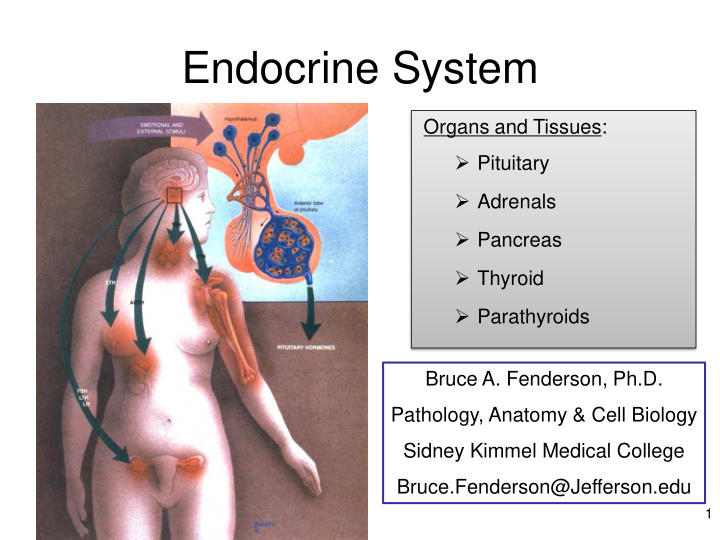



Endocrine System Organs and Tissues: Pituitary Adrenals Pancreas Thyroid Parathyroids Bruce A. Fenderson, Ph.D. Pathology, Anatomy & Cell Biology Sidney Kimmel Medical College Bruce.Fenderson@Jefferson.edu 1
Mechanisms of Cell Communication • Endocrine • Paracrine, autocrine • Synaptic • Neuroendocrine From Rubin ’ s Pathology, 2007 2
Development of the Pituitary (Neurohypophysis & Adenohypophysis) From Junqueira ’ s Basic Histology Text and Atlas 3
Pituitary Gland (Master Gland) From Wheater ’ s Functional Histology 4
Hypothalamo - Hypophyseal System • Oxytocin (PV) Hypothalamic • ADH (SO) Releasing Hormones Superior Hypophyseal Artery Inferior Hypophyseal Artery Herring Bodies 5
Anterior and Posterior Pituitary Primary Capillary Plexus Secondary Capillary Plexus From Wheater ’ s Functional Histology 6
Anterior Pituitary (Pars Distalis) Glandular epithelial cells with fenestrated capillaries Mixture of cell types producing different polypeptide hormones Acidophils Basophils Chromophobes Somatotrophs Lactotrophs Corticotrophs TSH, MSH, FSH 7
Immunolabeling Can Be Used to Localize Specific Pituitary Hormones Identification of hormone-producing cells using specific antibodies Method is used to help establish tumor diagnosis ( e.g., type of pituitary adenoma) 8
Dense, Membrane-Bound Secretory Granules Contain Pituitary Hormones 9
Pars Intermedia Epithelial cells representing the residuum of Rathke ’ s pouch Cords and follicles that produce some melanocyte- stimulating hormone (MSH) Anterior Pituitary Posterior Pituitary 10
Craniopharyngioma (tumor derived from remnants of Rathke ’ s pouch) 11
Posterior Pituitary (Pars Nervosa) Pituicytes - 25% of cells Non-myelinated axons from PV & SO nuclei Herring bodies (storage) ADH & Oxytocin Fenestrated capillaries 12
Herring Bodies in Neurohypophysis (dilated terminals of axons) 13
Multiple effects of pituitary hormones on target organs with feedback inhibition… 14
Adrenal (Suprarenal) Glands Developmentally regulated glands Pituitary-dependent function (ACTH) Extra-adrenal cortical and medullary tissues (relevant to rare tumors) from Junquiera and Carneiro, Basic Histology 15
Adrenal Cortex and Medulla 16
Vascular Supply to the Adrenals Glomerulosa Cortex Fasiculata Reticularis Medull a 17
Adrenal Zones and Hormones Cap ***Zona Glomerulosa Mineralocorticoid (aldosterone) ***Zona Fasiculata Glucocorticoids (cortisol) ***Zona Reticularis Weak androgens ***Medulla Epinephrine, norepinephrine 18
Zona Glomerulosa (Aldosterone) Thin outer zone adjacent to capsule Small clusters of cells continuous with cords below Aldosterone secretion regulated primarily by the renin-angiotensin system 19
Zona Fasiculata (Cortisol) Middle and broadest of the 3 cortical zones Narrow cords of secretory cells with intracellular lipid droplets in long parallel columns ( “ spongyocytes ” ) Separated by supporting tissue containing sinusoidal capillaries 20
Zona Reticularis (Weak Androgens) Medulla Glandular epithelium arranged in cords and nests. 21
Lipid Droplets in Steroid-Secreting Cells of the Adrenal Cortex 22
Congenital Adrenal Hyperplasia 23
Adrenal Medulla Cords of glandular epithelial cells supported by reticular fiber network Neural crest cells Modified sympathetic, postganglionic neurons 24
Chromaffin Cells Secrete Catacholamines* A – Adrenaline (epinephrine) N – Noradrenaline (norepinephrine) Stress response stimulated by cholinergic endings of pre- ganglionic sympathetic nerves 25
Endocrine Pancreas (Islets) Islets of Langerhans Micro-organs (approx. one million per pancreas) Polygonal cells with fine reticular fiber capsule Beta cells (70%) synthesize insulin Alpha cells (20%) synthesize glucagon 26
Blood Supply to Pancreatic Islets 1-3 arterioles per islet Branched, fenestrated capillaries Venules drain to interlobular veins 27
Localization of Pancreatic Hormones Insulin Glucagon Somatostatin VIP 28
Thyroid Gland Pituitary-dependent endocrine organ ( TSH ) Regulation of basal metabolic rate Extracellular storage of hormone as colloid ( thyroglobulin T3, T4 ) Highly vascularized tissue Follicular and para- follicular cells (C-cells) 29
Thyroid Follicles Filled with Colloid Follicles are distended with colloid Diameter is variable Range of epithelial cell morphologies Fenestrated capillaries 30
Follicles Store Thyroglobulin Follicles store thyroid hormone precursor (3 months) Pituitary-derived TSH stimulates thyroglobulin uptake and intracellular processing by epithelial cells Active T3 and T4 are then discharged into capillaries. Size of follicles and lining cells varies according to their activation state 31
Calcitonin Producing C-Cells Scattered neuroendocrine cells from neural crest reside within the basal lamina of the follicle or in clusters between follicles Referred to as parafollicular or clear C-cells Synthesize calcitonin to decrease serum calcium Medullary-type thyroid carcinoma is derived from these C-cells 32
Hyperthyroidism Normal regulation of thyroid follicular cells by pituitary TSH is circumvented by the production of anti-TSH receptor antibodies (autoimmune disease). The result is unrelenting stimulation of the thyroid gland and clinical features of hyperthyroidism (Graves disease). 33
Parathyroid Glands (4) 34
Parathyroid Glandular Epithelium Cord-like secretory cells and adipose tissue (A). Adipose tissue increases significantly with patient age. Composed of two cells types: Chief Cells chief cells (principal cells) and oxyphil cells. Adipocytes Chief cells synthesize and secrete parathyroid hormone ( PTH ) in response to Oxyphil Cells changes in blood calcium. 35
Parathyroid Gland ( H & E ) Chief cells (principal cells) secrete PTH to increase serum Ca Capillaries Oxyphil cells 36
Diffuse Neuroendocrine System An example of the diffuse neuroendocrine system is gastrin-producing cells of stomach ( APUD System ). Enteroendocrine cells may be located at any level in the mucosa, from the base of glands to the tips of villi. 37
Summary of Key Points • Pituitary (anterior & posterior lobes) • Adrenals (cortex 3 layers & medulla) • Pancreas (islets of Langerhans) • Thyroid (follicular & parafollicular C-cells) • Parathyroid (chief & oxyphil cells) 38
Endocrine Organs Thank you… Questions?
Recommend
More recommend